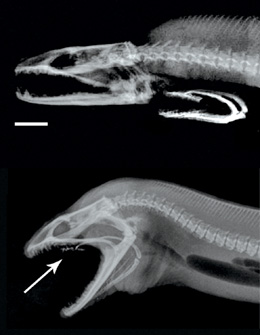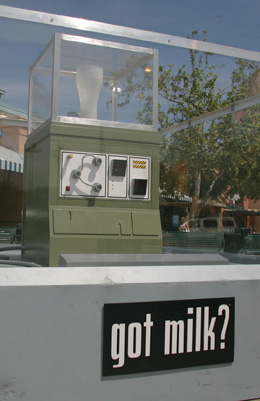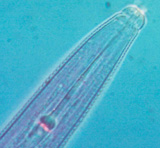Volume 25 · Number 2 · Winter 2008

These X-rays of a moray eel’s head reveal a second set of jaws — at rest in the eel’s throat, top, and launched forward, bottom, to seize its food. (Rita Mehta and Candi Stafford/UC Davis)
End Notes
Moray music
Findings by UC Davis researchers that moray eels have a second set of teeth tucked down in their throats, which reach up in the mouth to seize their prey à la Alien, generated widespread media coverage — and a new verse to an old song.
National Public Radio science correspondent Joe Palca interviewed postdoctoral fellow Rita Mehta about the discovery in September, then closed with a duet with Morning Edition host Steve Inskeep, sung to the tune of “That’s Amore:”
“When an eel bites your thigh as you’re just swimming by, it’s a moray.
When you scream and you beg, but it still bites your leg, that’s a moray.
There’s a thing on the reef with big white shining teeth, it’s a moray.
If he’s big and he’s mean and he’s slimy and green, it’s a moray.”
Mehta said later she was thrilled with the song. Just as rewarding, she said, were the responses from young listeners excited about her discovery. “The NPR news generated amazing e-mails from many parents on behalf of their kids. That was very awesome.”

We got milk!
Well, at least we’ve got the glass! The California Milk Processor Board auctioned off the prop that served as the centerpiece of this year’s “Got Milk” advertising campaign, and UC Davis was a double winner: Christine Bruhn, a Cooperative Extension food marketing specialist at UC Davis, placed the winning bid, and the milk board donated the proceeds to UC Davis for a student scholarship.
The board, noting UC Davis’ commitment to groundbreaking research and to educating students about the future of dairy, even augmented the proceeds, contributing $3,000 — enough to cover the cost of winter-quarter tuition for one lucky, dairy-food-loving student. The scholarship will be given to an Agricultural and Environmental Sciences student who writes the best 500-word essay about his or her passion for the dairy sciences.
And the glass? Bruhn is donating it to the university, which will display it in the soon-to-be finished Mondavi Institute for Wine and Food Science.

Nanoseal
This is a UC Davis seal, but you won’t find it on any official documents. Made by chemistry professor Gang-yu Liu with nanotechnology, the seal measures 8 micrometers, or 8 thousandths of a millimeter, in diameter. The smallest detail is less than one-thousandth the width of a human hair. To make it, Liu scraped away a layer of molecules on a gold surface with an atomic force microscope, then attached other molecules in their place. It took Liu, who uses this technology in her research, about 10 minutes to complete.
Discovery on the run
What does it take to discover a new species of nematode? For Professor Howard Ferris it took a 41-mile run on a trail through the San Gabriel mountains, mostly at night and, for 40 disheartening minutes, lost. That’s because Ferris made his discovery while serving as a crew member and pace runner for ultramarathoner Dan Williams during the grueling 2003 Angeles Crest race.

Ferris, an experienced ultramarathon runner himself, spent the first half of Williams’ run making sure the competitor had food and water at rest stops. In between, Ferris gathered soil samples so he would have live nematodes for his class back at UC Davis. Ferris then joined Williams at mile 59 and paced him to the finish — running alongside through the night, missing, at one crucial junction, a ribbon pointing the way.
But they completed the race, and Ferris received a most unusual reward for his efforts: When he put the nematodes under a microscope, he realized he had one he’d never seen before. With taxonomical assistance from John Chitambar, an adjunct professor and California Department of Food and Agriculture nematologist, he confirmed the tiny worm was a new member of the genus Geocenamus and christened it Geocenamus angelescresti in honor of the event and the discovery location. Chitambar and Ferris published the description of their new species in the December 2005 Journal of Nematology.
“I suspect that it’s very common to see a new species of nematode,” said Ferris — nematodes are, after all, the most abundant multicellular animals on earth. “But it’s not common to recognize one as such.” Even less common is having your discovery reported in the pages of a running magazine — Ferris and his find made the pages of UltraRunning magazine’s May 2007 issue.
